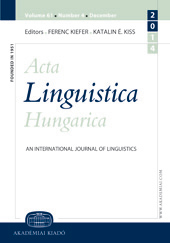Scrambling in Hungarian
Scrambling in Hungarian
Author(s): Balázs SurányiSubject(s): Syntax, Finno-Ugrian studies
Published by: Akadémiai Kiadó
Keywords: scrambling; (non)configurationality; Weak Crossover; binding; Hungarian;
Summary/Abstract: This article revisits the (non)configurationality debate of the 80s and early 90s concerning Hungarian, a “free word order” language, which was shown during that period to be characterized by an articulate and, crucially, hierarchical preverbal domain, with A-bar positions dedicated to discourse functions such as topic and focus. What this debate did not conclusively settle, however, is the question whether or not the structure of A-positions in Hungarian is also configurational. The most prevalent, and indeed empirically most well-argued and elaborated analysis that has emerged is that of E. Kiss’s (1987a; 1987b; 1991; 1994b; 2002; 2003), according to which the answer is negative: arguments are base-generated in the verb phrase in a free order in a flat structure. The present paper challenges this view by demonstrating systematically that the arguments put forward to back it up are inconclusive, and in fact it fails descriptively as well. The alternative proposed here is based on a hierarchical verb phrase (vacated by the raised verb) and a Japanese-type local scrambling movement that operates in the post-verbal domain of the clause. The scrambling movement analysis, besides being theoretically more desirable than the nonconfigurational verb phrase approach, makes available a superior descriptive coverage by accounting for a varied set of structural symmetries and asymmetries holding between subject and object. Modulo scrambling, Hungarian is configurational all the way down.
Journal: Acta Linguistica Hungarica (Since 2017 Acta Linguistica Academica)
- Issue Year: 53/2006
- Issue No: 4
- Page Range: 393-432
- Page Count: 40
- Language: English

